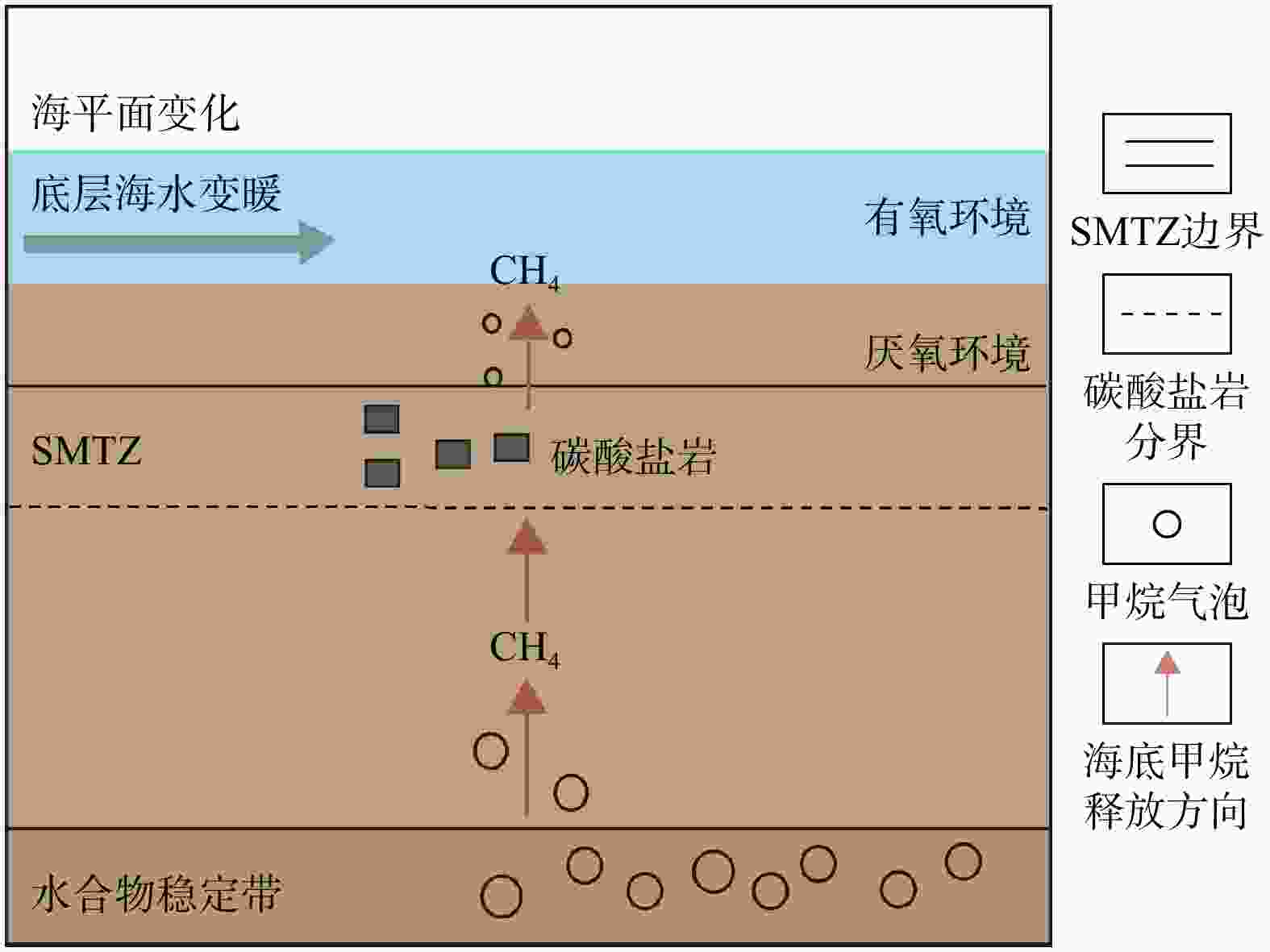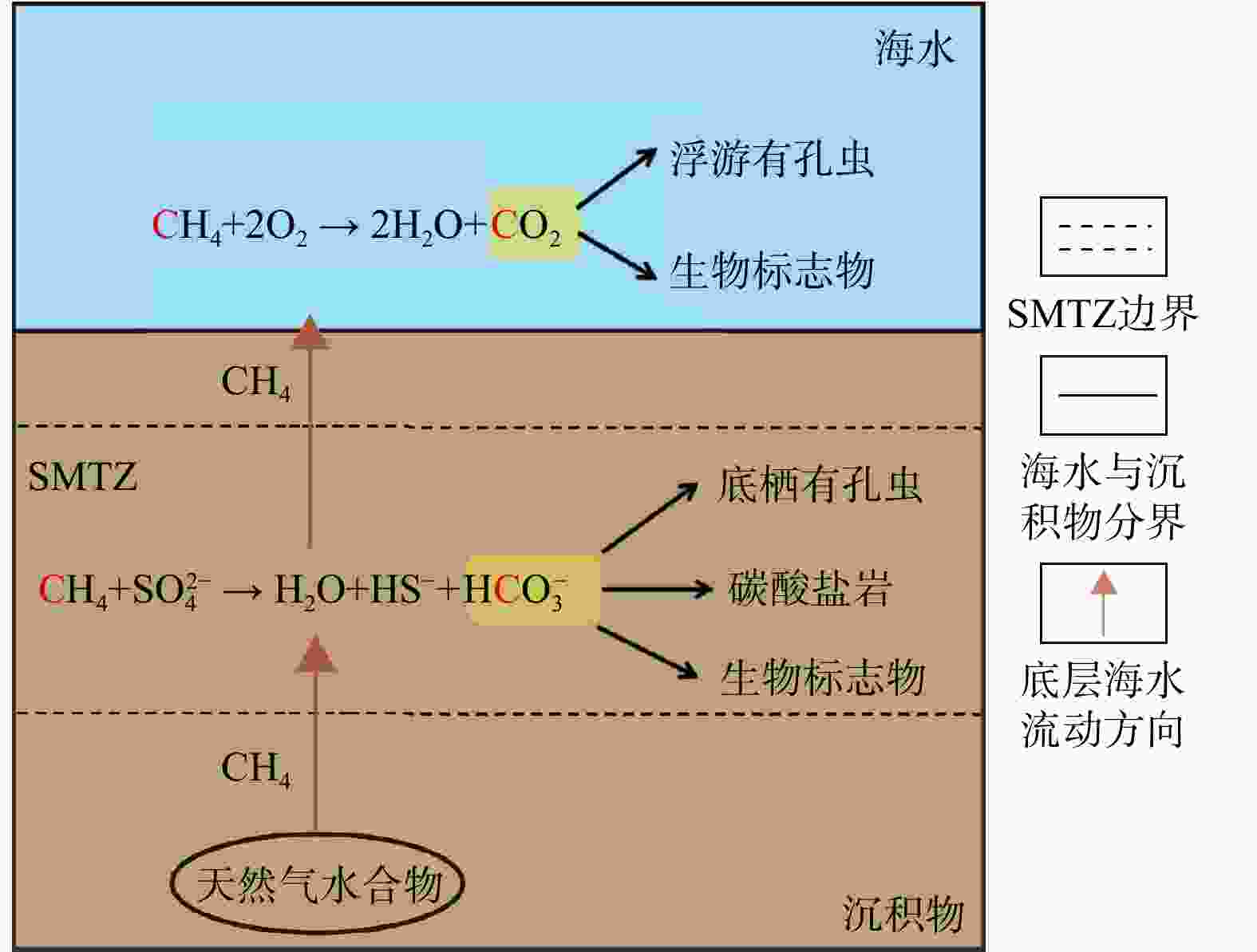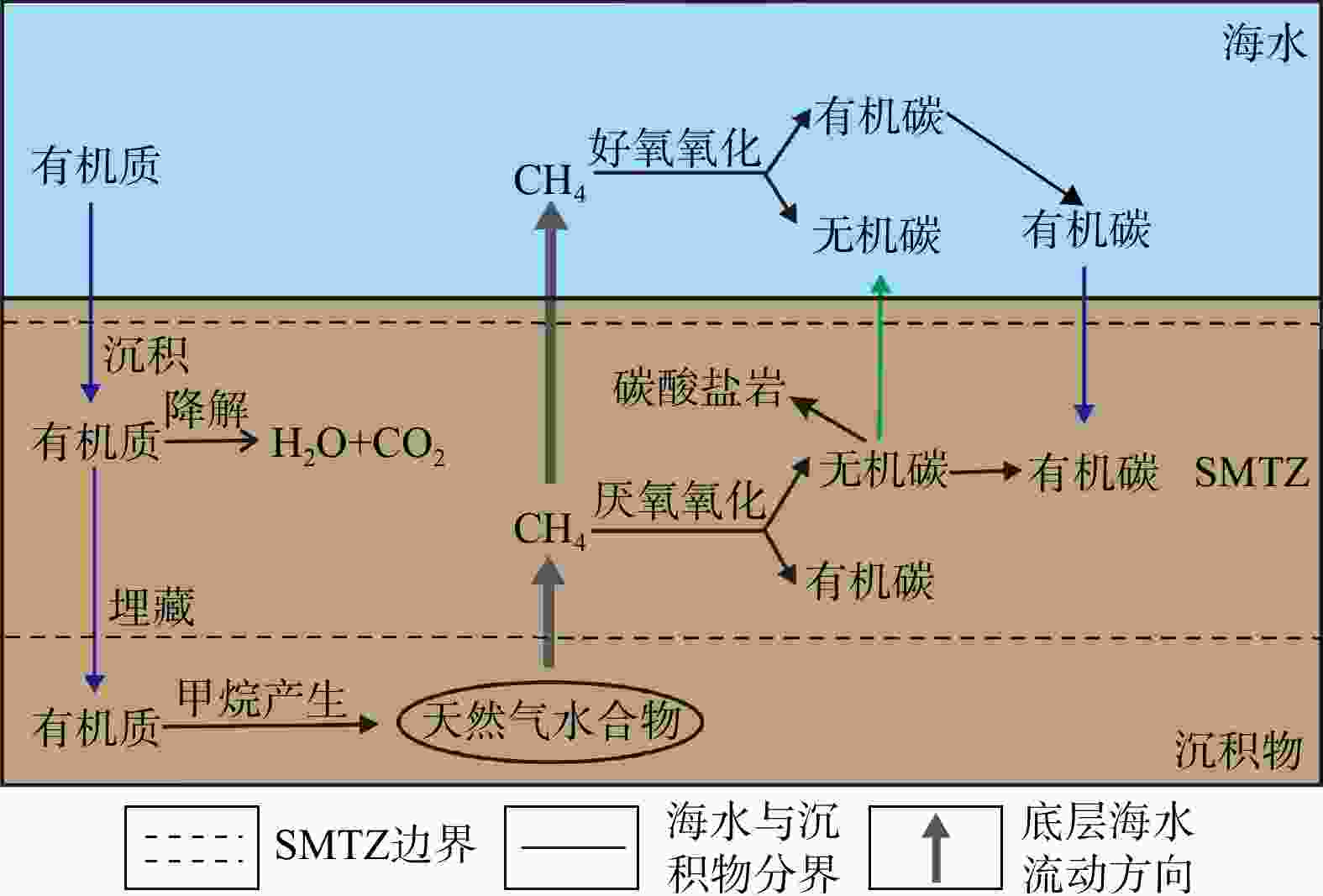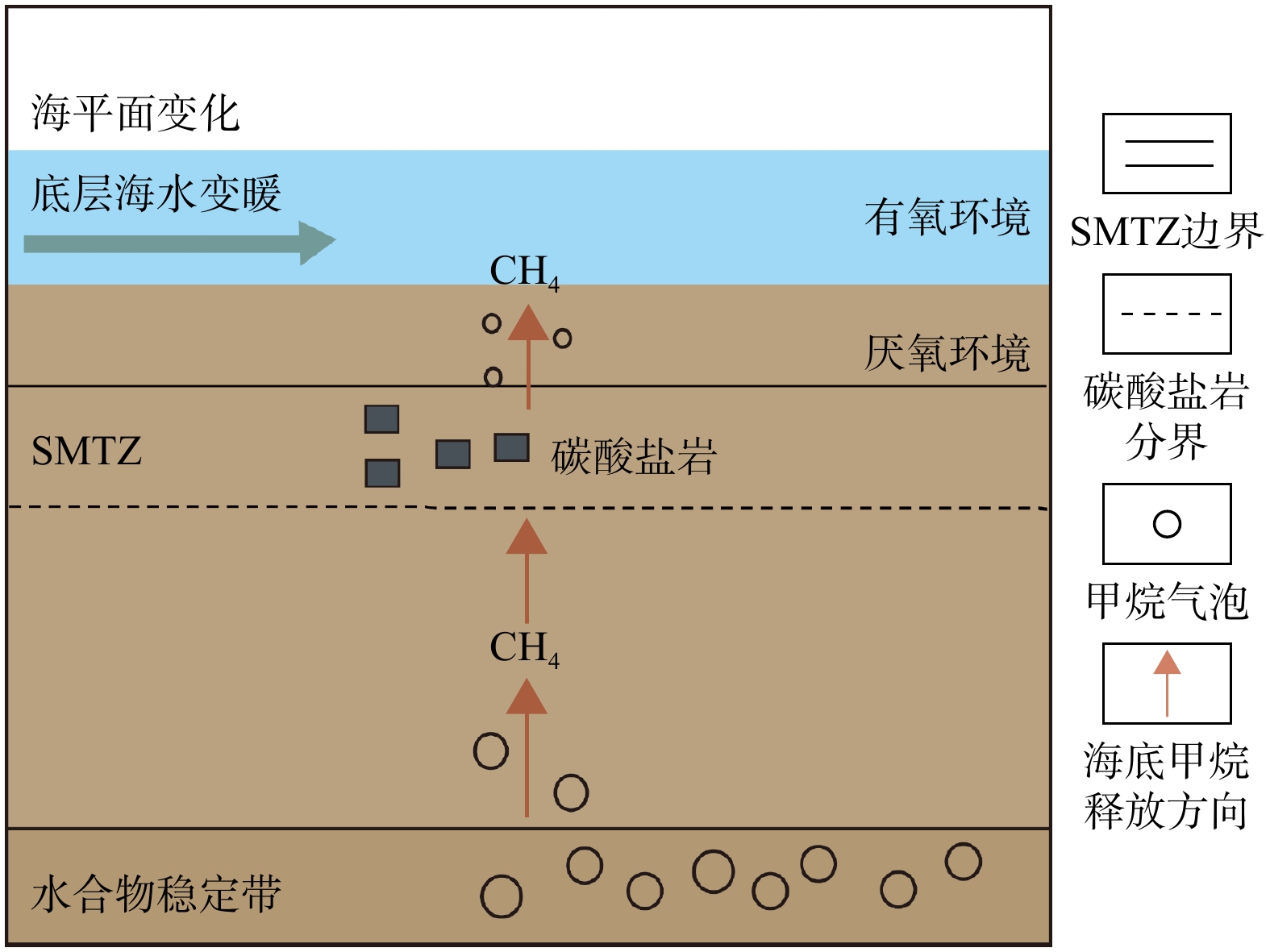Gas hydrate decomposition, methane conversion and burial of methane-derived carbon in the South China Sea
-
摘要:
天然气水合物是甲烷等天然气在高压、低温条件下形成的冰状固体物质,广泛存在于大陆边缘沉积物和永久冻土区,是重要的甲烷储库。海底天然气水合物分解释放的甲烷能够进入大气、加剧温室效应,也可以通过微生物活动被转化为有机和无机碳库。因此,甲烷衍生碳在沉积物中的埋藏能够有效减少进入大气中的甲烷通量,从而减缓甲烷释放造成的温室效应。中国南海具有独特的构造环境和沉积条件,是蕴藏天然气水合物的理想区域,在地质历史时期发生了多次甲烷渗漏事件。因此,深入研究南海海底甲烷释放记录、沉积物和水体中甲烷的转化过程以及甲烷衍生碳的埋藏,对于了解海洋碳循环以及天然气水合物对气候的调控作用具有重要的科学意义。对南海海底天然气水合物分解触发机制、识别甲烷释放事件的方法以及沉积物和水体中甲烷的转化过程进行了综述,聚焦沉积物和水体中的有机地球化学过程,对甲烷释放、转化和埋藏过程进行了总结,并介绍了基于碳酸盐岩、有孔虫、类脂生物标志物和沉积物碳硫微量元素系统学识别天然气水合物分解事件的前沿方法和相关研究工作。目前地质历史时期海洋冷泉环境下甲烷衍生有机碳的形成和埋藏的机制仍留有知识空白,缺乏对甲烷衍生有机碳埋藏的准确定量及其在海洋碳循环中作用的了解。对冷泉环境中甲烷向有机碳的转化研究进行了展望,以期为进一步研究极端环境下的海洋碳循环理论提供支撑。
Abstract:Significance Gas hydrates are ice-like solid substances formed by natural gas such as methane under high-pressure and low-temperature conditions, and are widely found in continental margin sediments and permafrost zones, serving as important methane reservoirs in marine environment. On the one hand, methane released from the decomposition of seafloor gas hydrates enters the atmosphere and exacerbates the greenhouse effect. On the other hand, methane released into sediments and seawater can be converted into organic and inorganic carbon through microbial activities. Therefore, the burial of methane-derived carbon in sediments can effectively reduce the methane flux into the atmosphere and meditate the greenhouse effect.
Discussion The South China Sea is an ideal area for harboring gas hydrates due to its tectonic and sedimentary environment. In this area, numerous historical methane seepage events have been reconstructed. To understand the role of gas hydrates in the marine carbon cycle and climate change, it is crucial to obtain in-depth perspectives of the methane release records in the South China Sea. Especially, the transformation of methane in sediments and seawater, as well as the burial of methane-derived carbon are of great scientific significance.
Prospect In this paper, we review the triggering mechanisms of gas hydrate decomposition, the methods of reconstructing methane release events, and the transformation processes of methane in cold seeps, with more focuses on the organic geochemical processes in sediments and water column. We summarize the methane release process, methane-derived carbon transformation and burial, and introduce the cutting-edge methodology and related research work for identifying gas hydrate decomposition events based on carbonate, foraminifera, biomarkers and sediment carbon-sulfur-trace element systematics. At present, there remain knowledge gaps in the mechanisms of formation and burial of methane-derived organic carbon in marine cold seep environments during geological history periods. Additionally, there is a lack of understanding regarding the accurate quantification of methane-derived organic carbon burial and its role in the marine carbon cycle. Based on the previous work, we provide an outlook on the conversion of methane to organic carbon in cold seep environments and a theoretical basis for the future researches concerning the role of methane-derived carbon in the marine carbon cycle.
-
Key words:
- gas hydrate /
- methane-derived carbon /
- South China Sea /
- ocean carbon cycle
-
-
[1] 贾永刚, 阮文凤, 胡乃利, 等. 现代暖期气候变暖对南海北部陆坡天然气水合物分解潜在影响[J]. 地学前缘, 2022, 29(4): 191-201.JIA Y G, RUAN W F, HU N L, et al. Hydrate dissociation on the northern slope of the South China Sea: Potential effects from climate warming in the current warm period[J]. Earth Science Frontiers, 2022, 29(4): 191-201. (in Chinese with English abstract [2] RUPPEL C D, KESSLER J D. The interaction of climate change and methane hydrates[J]. Reviews of Geophysics, 2017, 55(1): 126-168. doi: 10.1002/2016RG000534 [3] ZHAO J F, SONG Y C, LIM X L, et al. Opportunities and challenges of gas hydrate policies with consideration of environmental impacts[J]. Renewable and Sustainable Energy Reviews, 2017, 70: 875-885. doi: 10.1016/j.rser.2016.11.269 [4] TEICHERT B M A, EISENHAUER A, BOHRMANN G, et al. U/Th systematics and ages of authigenic carbonates from Hydrate Ridge, Cascadia Margin: Recorders of fluid flow variations[J]. Geochimica et Cosmochimica Acta, 2003, 67(20): 3845-3857. doi: 10.1016/S0016-7037(03)00128-5 [5] 栾锡武, 刘鸿, 岳保静, 等. 海底冷泉在旁扫声纳图像上的识别[J]. 现代地质, 2010, 24(3): 474-480. doi: 10.3969/j.issn.1000-8527.2010.03.009LUAN X W, LIU H, YUE B J, et al. Characteristics of cold seepage on side scan sonar sonogram[J]. Geoscience, 2010, 24(3): 474-480. (in Chinese with English abstract doi: 10.3969/j.issn.1000-8527.2010.03.009 [6] WANG M Y, CHEN T Y, FENG D, et al. Uranium-thorium isotope systematics of cold-seep carbonate and their constraints on geological methane leakage activities[J]. Geochimica et Cosmochimica Acta, 2022, 320: 105-121. doi: 10.1016/j.gca.2021.12.016 [7] ZHANG Z G, WANG Y, GAO L F, et al. Marine gas hydrates: Future energy or environmental killer?[J]. Energy Procedia, 2012, 16: 933-938. doi: 10.1016/j.egypro.2012.01.149 [8] 唐常锐, 徐秀刚, 孙秉才, 等. 天然气水合物分解诱发海底滑坡影响因素分析及致灾风险评价[J]. 海洋地质前沿, 2021, 37(5): 14-21.TANG C R, XU X G, SUN B C, et al. Influence factors and risk assessment for seabed landslides induced by natural gas hydrate decomposition[J]. Marine Geology Frontiers, 2021, 37(5): 14-21. (in Chinese with English abstract [9] SEROV P, VADAKKEPULIYAMBATTA S, MIENERT J, et al. Postglacial response of Arctic Ocean gas hydrates to climatic amelioration[J]. Proceedings of the National Academy of Sciences of the United States of America, 2017, 114(24): 6215-6220. [10] INGLIS G N, ROHRSSEN M, KENNEDY E M, et al. Terrestrial methane cycle perturbations during the onset of the Paleocene-Eocene thermal maximum[J]. Geology, 2021, 49(5): 520-524. doi: 10.1130/G48110.1 [11] DAVIES R J, MORALES MAQUEDA M Á, LI A, et al. Millennial-scale shifts in the methane hydrate stability zone due to Quaternary climate change[J]. Geology, 2017, 45(11): 1027-1030. doi: 10.1130/G39611.1 [12] GARCIA-TIGREROS F, LEONTE M, RUPPEL C D, et al. Estimating the impact of seep methane oxidation on ocean pH and dissolved inorganic radiocarbon along the U. S. mid-Atlantic bight[J]. Journal of Geophysical Research (Biogeosciences), 2021, 126(1): e2019JG005621. [13] 沈奥, 孙启良, 蔡砥柱, 等. 海底麻坑的特征、分类与成因机制[J]. 地质科技通报, 2023, 42(1): 204-217.SHEN A, SUN Q L, CAI D Z, et al. Characteristics, classification and genetic mechanism of pockmarks[J]. Bulletin of Geological Science and Technology, 2023, 42(1): 204-217. (in Chinese with English abstract [14] WALLMANN K, PINERO E, BURWICZ E, et al. The global inventory of methane hydrate in marine sediments: A theoretical approach[J]. Energies, 2012, 5(7): 2449-2498. doi: 10.3390/en5072449 [15] JUDD A G, HOVLAND M. Seabed fluid flow: The impact on geology, biology and the marine environment[M]. Cambridge, United Kingdom: Cambridge University Press, 2009. [16] MILKOV A V, SASSEN R, APANASOVICH T V, et al. Global gas flux from mud volcanoes: A significant source of fossil methane in the atmosphere and the ocean[J]. Geophysical Research Letters, 2003, 30(2): 1037. [17] YANG H L, YU S, LU H L. Iron-coupled anaerobic oxidation of methane in marine sediments: A review[J]. Journal of Marine Science and Engineering, 2021, 9(8): 875. doi: 10.3390/jmse9080875 [18] PARKES R J, WELLSBURY P, MATHER I D, et al. Temperature activation of organic matter and minerals during burial has the potential to sustain the deep biosphere over geological timescales[J]. Organic Geochemistry, 2007, 38(6): 845-852. doi: 10.1016/j.orggeochem.2006.12.011 [19] MIDDELBURG J J. A simple rate model for organic matter decomposition in marine sediments[J]. Geochimica et Cosmochimica Acta, 1989, 53(7): 1577-1581. doi: 10.1016/0016-7037(89)90239-1 [20] CUI M M, MA A Z, QI H Y, et al. Anaerobic oxidation of methane: An "active" microbial process[J]. Microbiology Open, 2015, 4(1): 1-11. doi: 10.1002/mbo3.232 [21] NAUHAUS K, ALBRECHT M, ELVERT M, et al. In vitro cell growth of marine archaeal-bacterial consortia during anaerobic oxidation of methane with sulfate[J]. Environmental Microbiology, 2007, 9(1): 187-196. doi: 10.1111/j.1462-2920.2006.01127.x [22] GUAN H X, LIU L, WU N Y, et al. South China Sea seeps[M]. Singapore: Springer Nature Singapore, 2023: 189-209. [23] JOYE S B, BOETIUS A, ORCUTT B N, et al. The anaerobic oxidation of methane and sulfate reduction in sediments from Gulf of Mexico cold seeps[J]. Chemical Geology, 2004, 205(3/4): 219-238. [24] 姚伯初. 南海天然气水合物的形成条件和分布特征[J]. 海洋石油, 2007, 27(1): 1-10. doi: 10.3969/j.issn.1008-2336.2007.01.001YAO B C. The forming condition and distribution characteristics of the gas hydrate in the South China Sea[J]. Offshore Oil, 2007, 27(1): 1-10. (in Chinese with English abstract doi: 10.3969/j.issn.1008-2336.2007.01.001 [25] 赵斌, 刘胜旋, 李丽青, 等. 南海冷泉分布特征及油气地质意义[J]. 海洋地质前沿, 2018, 34(10): 32-43.ZHAO B, LIU S X, LI L Q, et al. Distribution pattern of cold seeps in South China Sea and its geological significance[J]. Marine Geology Frontiers, 2018, 34(10): 32-43. (in Chinese with English abstract [26] WANG X D, GUAN H X, QIU J W, et al. Macro-ecology of cold seeps in the South China Sea[J]. Geosystems and Geoenvironment, 2022, 1(3): 100081. doi: 10.1016/j.geogeo.2022.100081 [27] FENG D, QIU J W, HU Y, et al. Cold seep systems in the South China Sea: An overview[J]. Journal of Asian Earth Sciences, 2018, 168: 3-16. doi: 10.1016/j.jseaes.2018.09.021 [28] YAO H Y, NIEMANN H, PANIERI G. Multi-proxy approach to unravel methane emission history of an Arctic cold seep[J]. Quaternary Science Reviews, 2020, 244: 106490. doi: 10.1016/j.quascirev.2020.106490 [29] TONG H P, FENG D, CHENG H, et al. Authigenic carbonates from seeps on the northern continental slope of the South China Sea: New insights into fluid sources and geochronology[J]. Marine and Petroleum Geology, 2013, 43: 260-271. doi: 10.1016/j.marpetgeo.2013.01.011 [30] GEBBIE G, HUYBERS P. The little ice age and 20th-century deep Pacific cooling[J]. Science, 2019, 363: 70-74. doi: 10.1126/science.aar8413 [31] DENG Y N, CHEN F, GUO Q J, et al. Possible links between methane seepages and glacial-interglacial transitions in the South China Sea[J]. Geophysical Research Letters, 2021, 48(8): e2020GL091429. doi: 10.1029/2020GL091429 [32] MIAO X M, FENG X L, LI J R, et al. Tracing the paleo-methane seepage activity over the past 20000 years in the sediments of Qiongdongnan Basin, northwestern South China Sea[J]. Chemical Geology, 2021, 559: 119956. doi: 10.1016/j.chemgeo.2020.119956[33] ZHANG G L, CAO J, DENG Y N, et al. A 209000 -year-old history of methane seepage activity controlled by multiple factors in the South China Sea[J]. Marine and Petroleum Geology, 2023, 151: 106200. doi: 10.1016/j.marpetgeo.2023.106200[34] 王钦贤, 陈多福. 地质历史时期天然气水合物分解释放的地质地球化学证据[J]. 现代地质, 2010, 24(3): 552-559. doi: 10.3969/j.issn.1000-8527.2010.03.020WANG Q X, CHEN D F. Geological and geochemical evidence for massive dissociation of gas hydrate in the geological history[J]. Geoscience, 2010, 24(3): 552-559. (in Chinese with English abstract doi: 10.3969/j.issn.1000-8527.2010.03.020 [35] MACKENSEN A, SCHMIEDL G. Stable carbon isotopes in paleoceanography: Atmosphere, oceans, and sediments[J]. Earth-Science Reviews, 2019, 197: 102893. doi: 10.1016/j.earscirev.2019.102893 [36] YAO H Y, HONG W L, PANIERI G, et al. Fracture-controlled fluid transport supports microbial methane-oxidizing communities at Vestnesa Ridge[J]. Biogeosciences, 2019, 16(10): 2221-2232. doi: 10.5194/bg-16-2221-2019 [37] DICKENS G R, O'NEIL J R, REA D K, et al. Dissociation of oceanic methane hydrate as a cause of the carbon isotope excursion at the end of the Paleocene[J]. Paleoceanography, 1995, 10(6): 965-971. doi: 10.1029/95PA02087 [38] CAESAR K H, KYLE J R, LYONS T W, et al. Carbonate formation in salt dome cap rocks by microbial anaerobic oxidation of methane[J]. Nature Communications, 2019, 10: 808. doi: 10.1038/s41467-019-08687-z [39] RUBAN A, RUDMIN M, DUDAREV O, et al. The formation of authigenic carbonates at a methane seep site in the northern part of the Laptev Sea[J]. Minerals, 2020, 10(11): 948. doi: 10.3390/min10110948 [40] PANIERI G, GRAVES C A, JAMES R H. Paleo-methane emissions recorded in foraminifera near the landward limit of the gas hydrate stability zone offshore western Svalbard[J]. Geochemistry, Geophysics, Geosystems, 2016, 17(2): 521-537. [41] KIM B, ZHANG Y G. Methane hydrate dissociation across the Oligocene-Miocene boundary[J]. Nature Geoscience, 2022, 15(3): 203-209. doi: 10.1038/s41561-022-00895-5 [42] TREUDE T, NIGGEMANN J, KALLMEYER J, et al. Anaerobic oxidation of methane and sulfate reduction along the Chilean continental margin[J]. Geochimica et Cosmochimica Acta, 2005, 69(11): 2767-2779. doi: 10.1016/j.gca.2005.01.002 [43] MAGALHÃES V H, PINHEIRO L M, IVANOV M K, et al. Formation processes of methane-derived authigenic carbonates from the Gulf of Cadiz[J]. Sedimentary Geology, 2012, 243: 155-168. [44] HAAS A, PECKMANN J, ELVERT M, et al. Patterns of carbonate authigenesis at the Kouilou pockmarks on the Congo deep-sea fan[J]. Marine Geology, 2010, 268(1/2/3/4): 129-136. [45] ALOISI G, PIERRE C, ROUCHY J M, et al. Methane-related authigenic carbonates of eastern Mediterranean Sea mud volcanoes and their possible relation to gas hydrate destabilisation[J]. Earth and Planetary Science Letters, 2000, 184(1): 321-338. doi: 10.1016/S0012-821X(00)00322-8 [46] THIEL V, PECKMANN J, RICHNOW H H, et al. Molecular signals for anaerobic methane oxidation in Black Sea seep carbonates and a microbial mat[J]. Marine Chemistry, 2001, 73(2): 97-112. doi: 10.1016/S0304-4203(00)00099-2 [47] CHEN F, WANG X D, LI N, et al. Gas hydrate dissociation during sea-level highstand inferred from U/Th dating of seep carbonate from the South China Sea[J]. Geophysical Research Letters, 2019, 46(23): 13928-13938. doi: 10.1029/2019GL085643 [48] 陈芳, 周洋, 吴聪, 等. 珠江口盆地东部陆坡末次冰期天然气水合物-冷泉活动的记录与时间[J]. 地学前缘, 2017, 24(4): 66-77.CHEN F, ZHOU Y, WU C, et al. Records and timing of gas hydrate and cold seep activity during the last glacial period from the east of the Pearl River Mouth Basin, South China Sea[J]. Earth Science Frontiers, 2017, 24(4): 66-77. (in Chinese with English abstract [49] BAYON G, HENDERSON G M, BOHN M. U-Th stratigraphy of a cold seep carbonate crust[J]. Chemical Geology, 2009, 260(1/2): 47-56. [50] HAN X Q, YANG K H, HUANG Y Y. Origin and nature of cold seep in northeastern Dongsha area, South China Sea: Evidence from chimney-like seep carbonates[J]. Chinese Science Bulletin, 2013, 58(30): 3689-3697. doi: 10.1007/s11434-013-5819-x [51] FENG D, CHEN D F. Authigenic carbonates from an active cold seep of the northern South China Sea: New insights into fluid sources and past seepage activity[J]. Deep Sea Research Part Ⅱ (Topical Studies in Oceanography), 2015, 122: 74-83. doi: 10.1016/j.dsr2.2015.02.003 [52] YANG K H, CHU F Y, ZHU Z M, et al. Formation of methane-derived carbonates during the last glacial period on the northern slope of the South China Sea[J]. Journal of Asian Earth Sciences, 2018, 168: 173-185. doi: 10.1016/j.jseaes.2018.01.022 [53] ZEEBE R E, BIJMA J, WOLF-GLADROW D A. A diffusion-reaction model of carbon isotope fractionation in foraminifera[J]. Marine Chemistry, 1999, 64(3): 199-227. doi: 10.1016/S0304-4203(98)00075-9 [54] HILL T M, KENNETT J P, VALENTINE D L. Isotopic evidence for the incorporation of methane-derived carbon into foraminifera from modern methane seeps, Hydrate Ridge, Northeast Pacific[J]. Geochimica et Cosmochimica Acta, 2004, 68(22): 4619-4627. doi: 10.1016/j.gca.2004.07.012 [55] ZHOU Y, DI P F, LI N, et al. Unique authigenic mineral assemblages and planktonic foraminifera reveal dynamic cold seepage in the southern South China Sea[J]. Minerals, 2020, 10(3): 275. doi: 10.3390/min10030275 [56] ZHANG B D, PAN M D, WU D D, et al. Distribution and isotopic composition of foraminifera at cold-seep Site 973-4 in the Dongsha area, northeastern South China Sea[J]. Journal of Asian Earth Sciences, 2018, 168: 145-154. doi: 10.1016/j.jseaes.2018.05.007 [57] 丁玲, 赵美训. 生物标志物及其碳同位素在冷泉区生物地球化学研究中的应用[J]. 海洋地质与第四纪地质, 2010, 30(2): 133-142.DING L, ZHAO M X. Application of biomarkers and carbon isotopes to cold seep biogeochemical processes[J]. Marine Geology & Quaternary Geology, 2010, 30(2): 133-142. ((in Chinese with English abstract [58] 黄谦, 陈容涛, 彭晓波, 等. 渤海湾盆地渤中凹陷古近系烃源岩生物标志物特征及其地质意义[J]. 地质科技通报, 2022, 41(3): 180-192.HUANG Q, CHEN R T, PENG X B, et al. Characteristics and geological significance of biomarkers from the Paleogene source rocks in Bozhong Sag, Bohai Bay Basin[J]. Bulletin of Geological Science and Technology, 2022, 41(3): 180-192. (in Chinese with English abstract [59] EGLINTON T I, EGLINTON G. Molecular proxies for paleoclimatology[J]. Earth and Planetary Science Letters, 2008, 275(1/2): 1-16. [60] HINRICHS K U, HMELO L R, SYLVA S P. Molecular fossil record of elevated methane levels in Late Pleistocene coastal waters[J]. Science, 2003, 299: 1214-1217. doi: 10.1126/science.1079601 [61] MÉNOT G, BARD E. Geochemical evidence for a large methane release during the last deglaciation from Marmara Sea sediments[J]. Geochimica et Cosmochimica Acta, 2010, 74(5): 1537-1550. doi: 10.1016/j.gca.2009.11.022 [62] ZHANG Y G, ZHANG C L, LIU X L, et al. Methane Index: A tetraether archaeal lipid biomarker indicator for detecting the instability of marine gas hydrates[J]. Earth and Planetary Science Letters, 2011, 307(3/4): 525-534. [63] GUAN H X, FENG D, WU N Y, et al. Methane seepage intensities traced by biomarker patterns in authigenic carbonates from the South China Sea[J]. Organic Geochemistry, 2016, 91: 109-119. doi: 10.1016/j.orggeochem.2015.11.007 [64] GE L, JIANG S Y, BLUMENBERG M, et al. Lipid biomarkers and their specific carbon isotopic compositions of cold seep carbonates from the South China Sea[J]. Marine and Petroleum Geology, 2015, 66: 501-510. doi: 10.1016/j.marpetgeo.2015.02.005 [65] GE L, JIANG S Y, YANG T, et al. Glycerol ether biomarkers and their carbon isotopic compositions in a cold seep carbonate chimney from the Shenhu area, northern South China Sea[J]. Chinese Science Bulletin, 2011, 56(16): 1700-1707. doi: 10.1007/s11434-011-4486-z [66] GUAN H X, BIRGEL D, PECKMANN J, et al. Lipid biomarker patterns of authigenic carbonates reveal fluid composition and seepage intensity at Haima cold seeps, South China Sea[J]. Journal of Asian Earth Sciences, 2018, 168: 163-172. doi: 10.1016/j.jseaes.2018.04.035 [67] PEKETI A, MAZUMDAR A, JOAO H M, et al. Coupled C-S-Fe geochemistry in a rapidly accumulating marine sedimentary system: Diagenetic and depositional implications[J]. Geochemistry, Geophysics, Geosystems, 2015, 16(9): 2865-2883. [68] PRICE F T, SHIEH Y N. Fractionation of sulfur isotopes during laboratory synthesis of pyrite at low temperatures[J]. Chemical Geology, 1979, 27(3): 245-253. doi: 10.1016/0009-2541(79)90042-1 [69] LI N, FENG D, CHEN L Y, et al. Using sediment geochemistry to infer temporal variation of methane flux at a cold seep in the South China Sea[J]. Marine and Petroleum Geology, 2016, 77: 835-845. doi: 10.1016/j.marpetgeo.2016.07.026 [70] HU Y, CHEN L Y, FENG D, et al. Geochemical record of methane seepage in authigenic carbonates and surrounding host sediments: A case study from the South China Sea[J]. Journal of Asian Earth Sciences, 2017, 138: 51-61. doi: 10.1016/j.jseaes.2017.02.004 [71] REEBURGH W S. Oceanic methane biogeochemistry[J]. ChemInform, 2007, 38(20): 486-513. [72] 段昌海, 张翠景, 孙艺华, 等. 新型产甲烷古菌研究进展[J]. 微生物学报, 2019, 59(6): 981-995.DUAN C H, ZHANG C J, SUN Y H, et al. Recent advances on the novel methanogens[J]. Acta Microbiologica Sinica, 2019, 59(6): 981-995. (in Chinese with English abstract [73] BOETIUS A, WENZHÖFER F. Seafloor oxygen consumption fuelled by methane from cold seeps[J]. Nature Geoscience, 2013, 6(9): 725-734. doi: 10.1038/ngeo1926 [74] LEVIN L A. Oceanography and marine biology[M]. Boca Raton: CRC Press, 2005: 11-56. [75] WALLENIUS A J, MARTINS P D, SLOMP C P, et al. Anthropogenic and environmental constraints on the microbial methane cycle in coastal sediments[J]. Frontiers in Microbiology, 2021, 12: 631621. doi: 10.3389/fmicb.2021.631621 [76] KIM B, ZHANG Y G. Methane Index: Towards a quantitative archaeal lipid biomarker proxy for reconstructing marine sedimentary methane fluxes[J]. Geochimica et Cosmochimica Acta, 2023, 354: 74-87. doi: 10.1016/j.gca.2023.06.008 [77] 牛明杨, 梁文悦, 王风平. 海洋环境中甲烷的生物转化及其对气候变化的影响[J]. 中国科学(地球科学), 2018, 48(12): 1568-1588. doi: 10.1360/N072017-00379NIU M Y, LIANG W Y, WANG F P. Methane biotransformation in the ocean and its effects on climate change: A review[J]. Scientia Sinica (Terrae), 2018, 48(12): 1568-1588. (in Chinese with English abstract doi: 10.1360/N072017-00379 [78] ELVERT M, HOPMANS E C, TREUDE T, et al. Spatial variations of methanotrophic consortia at cold methane seeps: Implications from a high-resolution molecular and isotopic approach[J]. Geobiology, 2005, 3(3): 195-209. doi: 10.1111/j.1472-4669.2005.00051.x [79] 冯东, 陈多福, 苏正, 等. 海底天然气渗漏系统微生物作用及冷泉碳酸盐岩的特征[J]. 现代地质, 2005, 19(1): 26-32. doi: 10.3969/j.issn.1000-8527.2005.01.004FENG D, CHEN D F, SU Z, et al. Characteristics of cold seep carbonates and microbial processes in gas seep system[J]. Geoscience, 2005, 19(1): 26-32. (in Chinese with English abstract doi: 10.3969/j.issn.1000-8527.2005.01.004 [80] KRISTENSEN E. Organic matter diagenesis at the oxic/anoxic interface in coastal marine sediments, with emphasis on the role of burrowing animals[J]. Hydrobiologia, 2000, 426(1): 1-24. doi: 10.1023/A:1003980226194 [81] DE LA FUENTE M, ARNDT S, MARÍN-MORENO H, et al. Assessing the benthic response to climate-driven methane hydrate destabilisation: State of the art and future modelling perspectives[J]. Energies, 2022, 15(9): 3307. doi: 10.3390/en15093307 [82] HINRICHS K U, BOETIUS A. Ocean margin systems[M]. Berlin, Heidelberg: Springer, 2003: 457-477. [83] HARRISON B K, ZHANG H S, BERELSON W, et al. Variations in archaeal and bacterial diversity associated with the sulfate-methane transition zone in continental margin sediments (Santa Barbara Basin, California)[J]. Applied and Environmental Microbiology, 2009, 75(6): 1487-1499. doi: 10.1128/AEM.01812-08 [84] XIN Y Z, WU N Y, SUN Z L, et al. Methane seepage intensity distinguish microbial communities in sediments at the Mid-Okinawa Trough[J]. Science of the Total Environment, 2022, 851: 158213. doi: 10.1016/j.scitotenv.2022.158213 [85] MEISTER P, LIU B, FERDELMAN T G, et al. Control of sulphate and methane distributions in marine sediments by organic matter reactivity[J]. Geochimica et Cosmochimica Acta, 2013, 104: 183-193. doi: 10.1016/j.gca.2012.11.011 [86] PANIERI G, LEPLAND A, WHITEHOUSE M J, et al. Diagenetic Mg-calcite overgrowths on foraminiferal tests in the vicinity of methane seeps[J]. Earth and Planetary Science Letters, 2017, 458: 203-212. doi: 10.1016/j.jpgl.2016.10.024 [87] POHLMAN J W, RIEDEL M, BAUER J E, et al. Anaerobic methane oxidation in low-organic content methane seep sediments[J]. Geochimica et Cosmochimica Acta, 2013, 108: 184-201. doi: 10.1016/j.gca.2013.01.022 [88] KONG Y, LEI H Y, ZHANG Z L, et al. Depth profiles of geochemical features, geochemical activities and biodiversity of microbial communities in marine sediments from the Shenhu area, the northern South China Sea[J]. Science of the Total Environment, 2021, 779: 146233. doi: 10.1016/j.scitotenv.2021.146233 [89] STOKKE R, ROALKVAM I, LANZEN A, et al. Integrated metagenomic and metaproteomic analyses of an ANME-1-dominated community in marine cold seep sediments[J]. Environmental Microbiology, 2012, 14(5): 1333-1346. doi: 10.1111/j.1462-2920.2012.02716.x [90] FELDEN J, WENZHÖFER F, FESEKER T, et al. Transport and consumption of oxygen and methane in different habitats of the Håkon Mosby Mud Volcano (HMMV)[J]. Limnology and Oceanography, 2010, 55(6): 2366-2380. doi: 10.4319/lo.2010.55.6.2366 [91] KNITTEL K, LÖSEKANN T, BOETIUS A, et al. Diversity and distribution of methanotrophic archaea at cold seeps[J]. Applied and Environmental Microbiology, 2005, 71(1): 467-479. doi: 10.1128/AEM.71.1.467-479.2005 [92] ROALKVAM I, JØRGENSEN S L, CHEN Y F, et al. New insight into stratification of anaerobic methanotrophs in cold seep sediments[J]. FEMS Microbiology Ecology, 2011, 78(2): 233-243. doi: 10.1111/j.1574-6941.2011.01153.x [93] AKAM S A, COFFIN R B, ABDULLA H A N, et al. Dissolved inorganic carbon pump in methane-charged shallow marine sediments: State of the art and new model perspectives[J]. Frontiers in Marine Science, 2020, 7: 206. doi: 10.3389/fmars.2020.00206 [94] CHATTERJEE S, DICKENS G R, BHATNAGAR G, et al. Pore water sulfate, alkalinity, and carbon isotope profiles in shallow sediment above marine gas hydrate systems: A numerical modeling perspective[J]. Journal of Geophysical Research (Solid Earth), 2011, 116(B9): B09103. [95] YANG S S, LV Y X, LIU X P, et al. Genomic and enzymatic evidence of acetogenesis by anaerobic methanotrophic archaea[J]. Nature Communications, 2020, 11: 3941. doi: 10.1038/s41467-020-17860-8 [96] USSLER W, PAULL C K. Rates of anaerobic oxidation of methane and authigenic carbonate mineralization in methane-rich deep-sea sediments inferred from models and geochemical profiles[J]. Earth and Planetary Science Letters, 2008, 266(3/4): 271-287. [97] VALENTINE D L, KASTNER M, WARDLAW G D, et al. Biogeochemical investigations of marine methane seeps, Hydrate Ridge, Oregon[J]. Journal of Geophysical Research (Biogeosciences), 2005, 110(G2): G02005. [98] POHLMAN J W, BAUER J E, WAITE W F, et al. Methane hydrate-bearing seeps as a source of aged dissolved organic carbon to the oceans[J]. Nature Geoscience, 2010, 4(1): 37-41. [99] WANG X C, CHEN R F, WHELAN J, et al. Contribution of "Old" carbon from natural marine hydrocarbon seeps to sedimentary and dissolved organic carbon pools in the Gulf of Mexico[J]. Geophysical Research Letters, 2001, 28(17): 3313-3316. doi: 10.1029/2001GL013430 [100] COFFIN R B, OSBURN C L, PLUMMER R E, et al. Deep sediment-sourced methane contribution to shallow sediment organic carbon: Atwater valley, Texas-Louisiana shelf, gulf of Mexico[J]. Energies, 2015, 8(3): 1561-1583. doi: 10.3390/en8031561 [101] HU T C, LUO M, XU Y P, et al. Production of labile protein-like dissolved organic carbon associated with anaerobic methane oxidization in the Haima cold seeps, South China Sea[J]. Frontiers in Marine Science, 2021, 8: 797084. doi: 10.3389/fmars.2021.797084 [102] LI N, JIN M, PECKMANN J, et al. Quantification of the sources of sedimentary organic carbon at methane seeps: A case study from the South China Sea[J]. Chemical Geology, 2023, 627: 121463. doi: 10.1016/j.chemgeo.2023.121463 [103] FENG D, POHLMAN J W, PECKMANN J, et al. Contribution of deep-sourced carbon from hydrocarbon seeps to sedimentary organic carbon: Evidence from radiocarbon and stable isotope geochemistry[J]. Chemical Geology, 2021, 585: 120572. doi: 10.1016/j.chemgeo.2021.120572 -





 下载:
下载:






